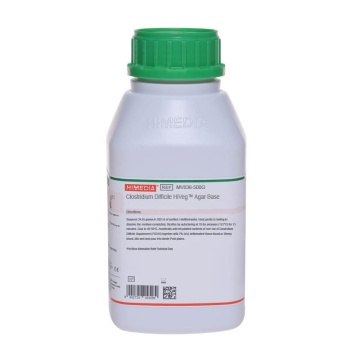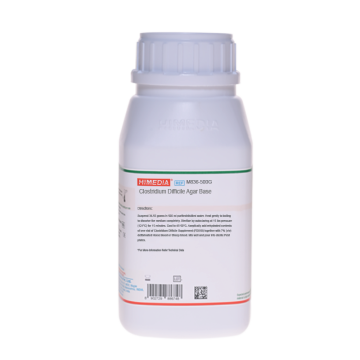 Your enquiry has been submitted
Your enquiry has been submitted
Clostridium Brazier Agar Base
Intended Use
Recommended as selective media for isolation and differentiation of Clostridium difficile with added supplements.
Composition**
| Ingredients | Gms / Litre |
|---|---|
| Peptone special | 23.000 |
| Sodium chloride | 5.000 |
| Starch, soluble | 1.000 |
| Sodium bicarbonate | 0.400 |
| Dextrose (Glucose) | 1.000 |
| Sodium pyruvate | 1.000 |
| L-Cysteine hydrochloride | 0.500 |
| Hemin | 0.010 |
| Vitamin K | 0.001 |
| L-Arginine | 1.000 |
| Sodium pyrophosphate | 0.250 |
| Sodium succinate | 0.500 |
| Cholic acid | 1.000 |
| p-Hydroxyphenylacetic acid | 1.000 |
| Agar | 12.000 |
Final pH (at 25°C): 7.0±0.2
**Formula adjusted, standardized to suit performance parameters
Directions
Suspend 47.66 grams in 1000 ml purified / distilled water. Heat to boiling to dissolve the medium completely. Sterilize by autoclaving at 15 lbs pressure (121°C) for 15 minutes. Cool to 45-50°C. Aseptically add rehydrated contents of 2 vials of Clostridium Difficile Supplement (FD010), 40 ml of Egg Yolk Emulsion (FD045) together with 10 ml lysed horse blood. Mix well and pour into sterile Petri plates.
Principle And Interpretation
The spectrum of disease caused by Clostridium difficile (a pathogenic Clostridium affecting the bowel) ranges from pseudomembranous colitis (PMC) through antibiotic associated colitis (AAC). It also includes chronic inflammatory bowel diseases, post-operative diarrhoea and non-antibiotic associated diarrhoea (2). Smith and King (6) first reported the presence of C. difficile in human infections.
This medium was developed by Jon Brazier (1) based on similar work carried out by Ken Phillips and Paul Levett. Many pathological labs including Anaerobe Reference Unit are using this medium for isolating C. difficile. Typical characteristics of C. difficile appears on this medium after 24 hours on anaerobic incubation at 35-37°C. C. difficile appears as grey, opaque, flat raised colonies generally circular but may tend to elongate, which on further incubation upto 48 hours may result in lighter grey or may impart white centre to the medium and form opaque colonies, 4-6 mm in diameter. Typical Gram stain morphology of C. difficile may not be seen in colonies taken from this medium due to the presence of antibiotics. The selective agents in Clostridium difficile supplement (FD010), D-cycloserine and cefoxitin used in this medium inhibits the growth of the majority of Enterobacteriaceae and also Enterococcus faecalis, Staphylococci, gram negative anaerobic bacilli and Clostridium species other than C. difficile which may be found abundantly in samples. The Egg Yolk Emulsion (FD045) added to the medium helps to differentiate C. difficile from lecithinase positive Clostridia. Addition of lysed horse blood to the base enhances recognition of colony fluorescence when cultures are examined using UV light. Cholic acid present in the medium promotes spore germination following shock treatment, and p-hydroxyphenylacetic acid to enhance production of p-cresol, a distinctive metabolite of C. difficile.
Type of specimen
Food samples
Specimen Collection and Handling
For food samples, follow appropriate techniques for sample collection and processing as per guidelines (5). After use, contaminated materials must be sterilized by autoclaving before discarding.
Warning and Precautions
Read the label before opening the container. Wear protective gloves/protective clothing/eye protection/ face protection. Follow good microbiological lab practices while handling specimens and culture. Standard precautions as per established guidelines should be followed while handling specimens. Safety guidelines may be referred in individual safety data sheets.
Limitations
- Gram stain morphology of C. difficile may not be seen in colonies taken from this medium due to the presence of antibiotics.
- Some isolates may show poor growth due to nutritional variations.
Quality Control
Appearance: Cream to yellow homogeneous free flowing powder
Gelling: Firm, comparable with 1.2% Agar gel
Colour and Clarity of prepared medium: Basal medium: Light amber coloured clear to slightly opalescent gel. After addition of Egg yolk emulsion (FD045) and 10 ml lysed horse blood: Tan coloured opaque gel forms in Petri plates.
Reaction: Reaction of 4.76% w/v aqueous solution at 25°C. pH : 7.0±0.2
pH: 6.80-7.20
Cultural Response: Cultural characteristics observed under anaerobic condition with added Clostridium Difficile Supplement (FD010), Egg yolk Emulsion (FD045) and 10 ml of lysed horse blood, after an incubation at 35-37°C for 48 hours.
| Organism | Inoculum (CFU) | Growth | Recovery | Colour of colony | Lecithinase activity |
|---|---|---|---|---|---|
| Clostridium difficile ATCC 11204 | 50-100 | good-luxuriant | >=50% | greyish-white, opaque flat colonies | negative |
| Escherichia coli ATCC 25922 (00013*) | >=10⁴ | inhibited | 0% |
Key :(*) Corresponding WDCM numbers.
Storage and Shelf Life
Store between 10-30°C in a tightly closed container and the prepared medium at 2-8°C. Use before expiry date on the label. On opening, product should be properly stored dry, after tightly capping the bottle in order to prevent lump formation due to the hygroscopic nature of the product. Improper storage of the product may lead to lump formation. Store in dry ventilated area protected from extremes of temperature and sources of ignition. Seal the container tightly after use. Product performance is best if used within stated expiry period.
Disposal
User must ensure safe disposal by autoclaving and/or incineration of used or unusable preparations of this product. Follow established laboratory procedures in disposing of infectious materials and material that comes into contact with clinical sample must be decontaminated and disposed of in accordance with current laboratory techniques (3,4).
Reference
- Brazier J S (1993) Role of the Laboratory in Investigations of Clostridium difficile Diarrhoea. Clinical Infectious Diseases 16 (4) S228-33.
- Collee J. G., Fraser A. G., Marmion B. P., Simmons A., (Eds.), Mackie and McCartney, Practical Medical Microbiology, 14th Ed., Churchill Livingstone.
- Isenberg, H.D. Clinical Microbiology Procedures Handbook 2nd Edition.
- Jorgensen, J.H., Pfaller, M.A., Carroll, K.C., Funke, G., Landry, M.L., Richter, S.S and Warnock., D.W. (2015) Manual of Clinical Microbiology, 11th Edition. Vol. 1.
- Salfinger Y., and Tortorello M.L. Fifth (Ed.), 2015, Compendium of Methods for the Microbiological Examination of Foods, 5th Ed., American Public Health Association, Washington, D.C.
- Smith L. D. S. and King E. O., 1962, J. Bacteriol., 84:65.
| Product Name | Clostridium Brazier Agar Base |
|---|---|
| SKU | M1803 |
| Product Type | Regular |
| Physical Form | Powder |
| Origin | Animal |
| Packaging type | HDPE |
| References | 1.Collee J. G., Fraser A. G., Marmion B. P., Simmons A., (Eds.), Mackie and McCartney, Practical Medical Microbiology,14th Ed., Churchill Livingstone. |
| Customized Product Available | No |








